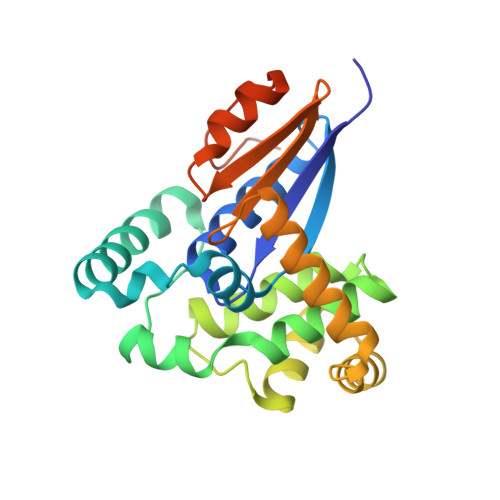Crystal structures and kinetic studies of human Kappa class glutathione transferase provide insights into the catalytic mechanism.
Wang, B., Peng, Y., Zhang, T., Ding, J.(2011) Biochem J 439: 215-225
- PubMed: 21728995
- DOI: https://doi.org/10.1042/BJ20110753
- Primary Citation of Related Structures:
3RPN, 3RPP - PubMed Abstract:
GSTs (glutathione transferases) are a family of enzymes that primarily catalyse nucleophilic addition of the thiol of GSH (reduced glutathione) to a variety of hydrophobic electrophiles in the cellular detoxification of cytotoxic and genotoxic compounds. GSTks (Kappa class GSTs) are a distinct class because of their unique cellular localization, function and structure. In the present paper we report the crystal structures of hGSTk (human GSTk) in apo-form and in complex with GTX (S-hexylglutathione) and steady-state kinetic studies, revealing insights into the catalytic mechanism of hGSTk and other GSTks. Substrate binding induces a conformational change of the active site from an 'open' conformation in the apo-form to a 'closed' conformation in the GTX-bound complex, facilitating formations of the G site (GSH-binding site) and the H site (hydrophobic substrate-binding site). The conserved Ser(16) at the G site functions as the catalytic residue in the deprotonation of the thiol group and the conserved Asp(69), Ser(200), Asp(201) and Arg(202) form a network of interactions with γ-glutamyl carboxylate to stabilize the thiolate anion. The H site is a large hydrophobic pocket with conformational flexibility to allow the binding of different hydrophobic substrates. The kinetic mechanism of hGSTk conforms to a rapid equilibrium random sequential Bi Bi model.
Organizational Affiliation:
State Key Laboratory of Molecular Biology and Research Center for Structural Biology, Institute of Biochemistry and Cell Biology, Shanghai Institutes for Biological Sciences, Chinese Academy of Sciences, Shanghai 200031, China.















